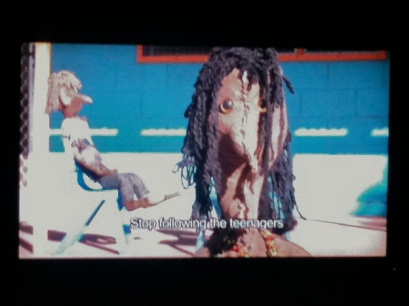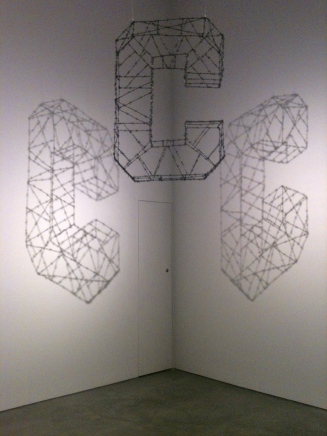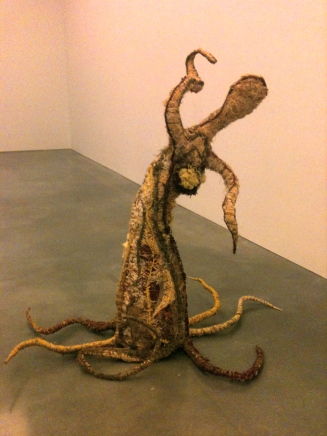String Theory
String Theory at the Museum of Contemporary Art in Sydney is a memorable and often deeply poignant exhibition curated by Glen Barkley. The show brings together aesthetically and conceptually diverse works by Indigenous artist from across Australia – all thematically tied by a ubiquitous, deceivingly simple and fundamental element – string.

Frances Djulibing
Yukuwa (Feather string yam vine), 2013
Banyan tree bark, cockatoo feathers, beeswax
The works are conceptually timely. Some works carry heavy political undertones. Some celebrate collaborative construction, where traditional weaving methods, alive and well, are shared with each new generation. Many works involve a hybridised aesthetic where traditional materials or ways of working are synthesised with diverse ideas and new mediums. The art is critical within the contemporary scene, flourishing and valued within and without the ‘white cube’.

Dale Harding
bright eyed little dormitory girls, 2013
hession sacks, mohair wool

Yarrenyty Arltere Artists
Little Dingi (still), 2012
DVD
viewable online at: http://www.youtube.com/watch?v=ea8WJuRwPLc
(some textile characters from animation below)


From video to sculpture to interdisciplinary crossovers, the eclectic range of works are woven thick with stories. There are stories to be remembered and retold; to be revered or reviled, evoking rapture or remorse – or perhaps a complex confusion of everything. Hidden histories, tragedy, hope, resilience, and beauty are the interwoven fibres that thread throughout the exhibition,with a strong sense of community at its heart.

Laurie Nilson
Just another Black C, 2011
Powder coated barbwire

Vivki West
plamtennor/gathering, 2013
Bull kelp, kangaroo skin, wallaby skins, tea tree, string
String Theory is an intimate, immersive collection of shared and diverse stories, both political and personal, culturally important within a contemporary social climate of conflicting interests, ongoing battles for justice and inspiring communities bustling with creative energy.

Tjanpi Desert Weavers
Minya Punu Kungkarangkalpa, installation detail, 2013
————————————————————————————————-
Embedded: Craig Walsh
Gazing across on the first floor of the MCA, one is lured by faint lights and the rumblings of distant voices into a cavernous, darkened gallery space sheltering video works, photographs, and 21 immense industrial bins of iron ore. Upon entering Embedded – a show produced by the artist Craig Walsh in collaboration with the Murujuga Aboriginal Corporation, the MCA and Rio Tinto, one is submerged into a spiritual space…a sacred space, as a chill runs through the room – pervading silence broken gently by the melodic voices of Murujuga Aboriginal elders spilling from speakers beside glowing screens. Navigating pathways between mountainous piles of illuminated orange iron ore in metal containers and wrapped by walls painted half blue, half yellow, with a fluorescent strip between – the colours of Rio Tinto mining uniforms, one senses a heavy solemnity…a resonating mournfulness.

Craig Walsh
Embedded: Craig Walsh, installation view, MCA
Image by Alex Davies from MCA website
Along one side of the room is a multi-screened installation of digital video works titled In Country. Onto sacred sites, textured by bush and rock formations within the Burrup Peninsula in north west Western Australia, sunburnt projections of Murujuga elders are cast. Their weathered faces are ’embedded’ in the landscape – the earth so deeply connected to spirituality, art and culture within Indigenous communities. Screens sequenced to illuminate one after another with an image of a member of the local indigenous community breathe life into the rugged rocks, the faces narrating Murujuga historical and ongoing presence and significance in an almost otherworldly performance.


The space is utterly absorbing; one feels the emotional weight of lingering tension between contested interests, personal and political. As the artist Craig Walsh explains, “I see the Pilbara as a place which uniquely presents a concentration of extremes… The contrast between the ‘land’ as commodity and ‘Land’ as spiritual and cultural guidance are co-existing in the installation, and the audience will be physically positioned somewhere between the two”. *

Craig Walsh,
Embedded: Craig Walsh, installation view, MCA, 2013
The Burrup Peninsula is home to the world’s largest collection of ancient Indigenous rock artworks, some estimated to be up to 30,000 years old *. Embedded within the environment, the works are of incredibly deep cultural, historical and spiritual importance. Located along the West Pilbara Coast – considered the “engine room of the nation” *, it is also home to a number of national and multinational corporations that carry out various industrial activities in the area. This includes the multi-billion dollar company Rio-Tinto, it’s presence in the Pilbara involving “a network of 14 iron ore mines, three port facilities, a 1,400 kilometre rail network; and related infrastructure”. * According to the ‘Stand Up for the Burrup’ website run by the Friends of Australian Rock Art (FARA) activist group, the Western Australia state government “continues to invest in industrial infrastructure on the Burrup”, with plans to “turn the Burrup into the main industrial hub for the Asia Pacific region”. * Nearly 20% of the rock art in the area has been destroyed or disturbed by industrial activity, FARA Chair Judith Hugo states. *

Craig Walsh
In Country (detail), 2012
Embedded: Craig Walsh, installation view, MCA, 2013
Embedded constructs an interesting dialogue between the complex tensions and interactions within the Pilbara concerning it’s unique environment of rich natural and cultural resources and how they are valued. Major corporations’ right to plunge into a natural ecosystem for the self-engorgement of profit, and the significance of the land and it’s art to local Indigenous culture and spirituality – and broader Australian society – are thrown up into question. With poetic and multi-sensory beauty, Walsh transports the realities of coexisting and colliding worlds into the contemplative, timeless space of the gallery.
Here is a link to the project’s website with more information: Murujuga in the Pilbara
String Theory runs until the 27th of October and Embedded: Craig Walsh until the 24th of November. Both exhibitions were deeply touching, poetic, and politically and culturally important – a visit comes highly recommended!
* References (in order of appearance in text):
MCA Media Release – Embedded: Craig Walsh
Australian Geographic – Burrup Peninsula rock art among world’s oldest
Karratha Visitor Centre – Mining and Industry
Rio Tinto – Iron Ore
Friends of Australian Rock Art –Stand Up for the Burrup
Australian Geographic – New threats to world’s largest rock art collection
